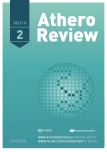Hyperlipidemic crisis as a risk factor for acute pancreatitis
Authors:
Martin Bajer; Jo O Fortunato; Jan Maňák; Vladimír Bláha
Authors‘ workplace:
III. interní gerontometabolická klinika LF Univerzity Karlovy a FN Hradec Králové
Published in:
AtheroRev 2023; 8(2): 109-111
Category:
Reviews
Overview
Hypertriglyceridemia is one of the conditions that can cause one of the most severe forms of acute pancreatitis (AP). There is a very high risk of developing persistent multi-organ failure and abdominal catastrophe [1]. The incidence of acute pancreatitis due to hypertriglyceridemia is increasing worldwide. Given the inappropriate dietary habits of mainly Western populations, the obesity pandemic and lack of exercise, this trend can be expected to intensify [2]. The aforementioned causes currently account for up to one-third of AP cases in some populations. Acute pancreatitis typically develops when hypertriglyceridemia is > 1,000 mg/dl (> 11.3 mmol/l). Although the specific treatment of acute pancreatitis is still unknown, there is a possibility of using an intervention in the form of therapeutic plasmapheresis, with which we have long experience at our department.
Keywords:
acute pancreatitis – hypertriglyceridemia – plasmapheresis
Sources
1. Kiss L, Fűr G, Mátrai P et al. The effect of serum triglyceride concentration on the outcome of acute pancreatitis: systematic review and meta - -analysis. Sci Rep 2018; 8(1): 14096. Dostupné z DOI: <http://doi: 10.1038/ s41598–018–32337-x>.
2. Carroll MD, Kit BK, Lacher DA et al. Trends in lipids and lipoproteins in US adults, 1988–2010. JAMA 2012; 308(15): 1545–1554. Dostupné z DOI: <http://doi: 10.1001/jama.2012.13260>.
3. Murphy MJ, Sheng X, MacDonald et al. Hypertriglyceridemia and acute pancreatitis. JAMA Intern Med 2013; 173(2): 162–164. Dostupné z DOI: <http://doi: 10.1001/2013.jamainternmed.477>.
4. Mosztbacher D, Hanák L, Farkas N et al. Hypertriglyceridemia-induced acute pancreatitis: A prospective, multicenter, international cohort analysis of 716 acute pancreatitis cases. Pancreatology 2020; 20(4): 608–616. Dostupné z DOI: <http://doi: 10.1016/j.pan.2020.03.018>.
5. Murphy MJ, Sheng X, MacDonald et al. Hypertriglyceridemia and acute pancreatitis. JAMA Intern Med 2013; 173(2): 162–164. Dostupné z DOI: <http://doi: 10.1001/2013.jamainternmed.477>.
6. Banks PA, Bollen TL, Dervenis C et al. [Acute Pancreatitis Classification Working Group]. Classification of acute pancreatitis – 2012: revision of the Atlanta classification and definitions by international consensus. Gut 2013; 62(1): 102–111. Dostupné z DOI: <http://doi: 10.1136/ gutjnl-2012–302779>.
7. Havel RJ. Pathogenesis, differentiation and management of hypertriglyceridemia. Adv Intern Med 1969; 15 : 117–154.
8. Navina S, Acharya C, DeLany JP et al. Lipotoxicity causes multisystem organ failure and exacerbates acute pancreatitis in obesity. Sci Transl Med 2011; 3(107): 107–110. Dostupné z DOI: <http://doi: 10.1126/ scitranslmed.3002573>.
9. Goldberg IJ. Lipoprotein lipase and lipolysis: central roles in lipoprotein metabolism and atherogenesis. J Lipid Res 1996; 37(4): 693–707.
10. Navina S, Acharya C, DeLany JP et al. Lipotoxicity causes multisystem organ failure and exacerbates acute pancreatitis in obesity. Sci Transl Med 2011; 3(107): 107–110. Dostupné z DOI: <http://doi: 10.1126/ scitranslmed.3002573>.
11. Weintraub M, Rassin T, Eisenberg S et al. Continuous intravenous heparin administration in humans causes a decrease in serum lipolytic activity and accumulation of chylomicrons in circulation. J Lipid Res 1994; 35(2): 229–238.
12. Weintraub M, Rassin T, Eisenberg S et al. Continuous intravenous heparin administration in humans causes a decrease in serum lipolytic activity and accumulation of chylomicrons in circulation. J Lipid Res 1994; 35(2): 229–238.
13. Bláha M, Vanásek J, Jebavý L et al. Therapeutic plasmapheresis. Literature review and personal experience with therapy. Vnitr Lek 1984; 30(3): 268–278.
14. Zadák Z et al. Treatment of hyperlipoproteinaemias using plasma exchange. Sb Ved Pr Lek Fak Karlovy Univerzity Hradci Kralove 1982; 25(1): 43–73.
15. Julius U, Parhofer KG, Heibges A et al. Dextran-sulfate-adsorption of atherosclerotic lipoproteins from whole blood or separated plasma for lipid - apheresis comparison of performance characteristics with DALI and Lipidfiltration. J Clin Apher 2007; 22(4): 215–223. Dostupné z DOI: <http:// doi: 10.1002/jca.20135>.
16. Stefanutti C, Labbadia G, Morozzi. Severe hypertriglyceridemia-related acute pancreatitis. Ther Apher Dial 2013; 17(2): 130–137. Dostupné z DOI: <http://doi: 10.1111/1744–9987.12008>.
17. Zádori N, Gede N, Antal J et al. EarLy Elimination of Fatty Acids iN hypertriglyceridemia - induced acuTe pancreatitis (ELEFANT trial): Protocol of an open-label, multicenter, adaptive randomized clinical trial. Pancreatology 2020; 20(3): 369–376. Dostupné z DOI: <http://doi: 10.1016/j. pan.2019.12.018>.
Labels
Angiology Diabetology Internal medicine Cardiology General practitioner for adultsArticle was published in
Athero Review

2023 Issue 2
- Metamizole vs. Tramadol in Postoperative Analgesia
- Memantine in Dementia Therapy – Current Findings and Possible Future Applications
- Metamizole at a Glance and in Practice – Effective Non-Opioid Analgesic for All Ages
- Metamizole in perioperative treatment in children under 14 years – results of a questionnaire survey from practice
- Memantine Eases Daily Life for Patients and Caregivers
Most read in this issue
- Bempedoic acid in the context of current hypolipidemic treatment options and the results of the CLEAR OUTCOMES trial
- Statement CSAT on Consensus statement of the European Atherosclerosis Society: Lipoprotein(a) in atherosclerotic cardiovascular disease and aortic stenosis
- The importance of nonstatin therapies for LDL-cholesterol lowering in the management of very high and high atherosclerotic cardiovascular risk
- Hyperlipidemic crisis as a risk factor for acute pancreatitis
